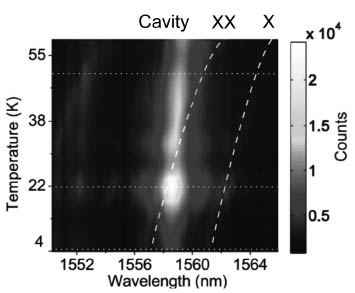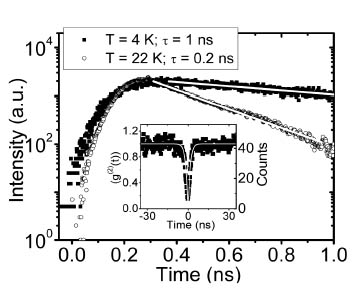1Optical Science Laboratory, 2Nanophotonics Center, 3NTT Photonics Laboratories
A telecom-band (1.55 µm) single photon source is
an important feature for the quantum communication networks, quantum repeaters,
and all optical quantum information processing via optical fibers as this
wavelength provides the lowest loss for long-distance transmission. Single
InAs/InP quantum dot (QD) is an attractive emitter while a coupling of
this single QD with a cavity yields a faster and brighter single photon
source [1]. Single photon emission at 1.55 µm with shortest radiative
recombination time of 1.12 ns from a single InAs QD in InP optical horn
was previously reported [2]. However, there is no report for the single
photon at 1.55 µm from the coupling between a single QD and a resonant
cavity.
We demonstrate a fast single photon source at 1.55-µm telecom band from the coupling of the single QD with the cavity of the photonic crystals [3]. We combine the coupling of the biexciton (XX) of the single QD and the cavity, which may yield a faster single photon source than that of the exciton (X). Fig. 1 exhibits temperature-dependent photoluminescence spectra. The cavity is a line defect with hole-distance modulations. From the fit of the cavity peak, we obtain an experimental Q of 2,000. We observe that the QD biexciton and the cavity are in resonance
at 22 K. At this temperature, we measure a very fast emission of 0.2 ns
due to the Purcell effect with the five-fold emission rate enhancement,
see Fig. 2. Photon intensity correlation measurement shows an antibunching
with g(2)(0) of 0.1. Such fast single photon source at telecom band has a potential
to improve the modulation rate of the long-distance quantum networks.
[1] A. J. Shields, Nature Photon. 1 (2007) 215.
[2] K. Takemoto et al., Appl. Phys. Express 3 (2010) 092802.
[3] M. D. Birowosuto et al., Sci. Rep. 2 (2012) 312.
 |
 |
|||||
|
|